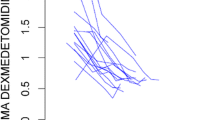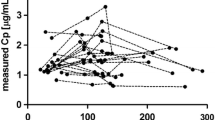Abstract
Due to the nature of ultra-short-acting opioid remifentanil of high time-varying, complex compartment model and low-accuracy of plasma concentration prediction, the traditional estimation method of population pharmacokinetics parameters, nonlinear mixed effects model (NONMEM), has the abuses of tedious work and plenty of man-made jamming factors. The Elman feedback neural network was built. The relationships between the patients’ plasma concentration of remifentanil and time, patient’ age, gender, lean body mass, height, body surface area, sampling time, total dose, and injection rate through network training were obtained to predict the plasma concentration of remifentanil, and after that, it was compared with the results of NONMEM algorithm. In conclusion, the average error of Elman network is −6.34%, while that of NONMEM is 18.99%. The absolute average error of Elman network is 27.07%, while that of NONMEM is 38.09%. The experimental results indicate that Elman neural network could predict the plasma concentration of remifentanil rapidly and stably, with high accuracy and low error. For the characteristics of simple principle and fast computing speed, this method is suitable to data analysis of short-acting anesthesia drug population pharmacokinetic and pharmacodynamics.
Similar content being viewed by others
References
SCHUTTLE J, SCHWIIDER H, STOEKEL H. Pharmacokinetics as applied to total intravenous anesthesia [J]. Practical Implication. Anesthesia, 1983, 38(1): 53–56.
ROSOT C. Remifentanil: A unique opioid analgesics [J]. Anesthesiology, 1993, 79(5): 875–876.
RICHEBE P, POUQUET O, JELACIC S, MEHTA S, CALDERON J, PICARD W, RIVAT C, CAHANA A, JANVIER G. Target-controlled dosing of remifentanil during cardiac surgery reduces postoperative hyperalgesia [J]. Journal of Cardiothoracic and Vascular Anesthesia, 2011, 25(6): 917–925.
ZHANG Xu-yu, HE Wen, WU Xiao-dan, ZHOU X, HUANG W, FENG X. TCI remifentanil vs. TCI propofol for awake fiber-optic intubation with limited topical anesthesia [J]. International Journal of Clinical Pharmacology and Therapeutics, 2012, 50(1): 10–16.
RAI M R, PARRY T M, DOMBROVSKIS A, WARNER O J. Remifentanil target-controlled infusion vs propofol target-controlled infusion for conscious sedation for awake fibreoptic intubation: A double-blinded randomized controlled trial [J]. British Journal of Anesthesia, 2008, 100(1): 125–130.
LEWIS B S, BARR R, VINAY V M. Estimation of population characteristics of pharmacokinetic parameters from routine clinical data [J]. Journal of Pharmacokinetics and Biopharmaceutics, 1977, 5(5): 445–479.
YAO Chang, CHEN Hou-jin. Automated retinal blood vessels segmentation based on simplified PCNN and fast 2D-Otsu algorithm [J]. Journal of Central South University of Technology, 2009, 16: 640–646.
SERRETTI A, ZANARDI R, MANDELLI L, SMERALDI E, COLDMBO C. A neural network model for combining clinical predictors of antidepressant response in mood disorders [J]. Journal of Affective Disorders, 2007, 98(3): 239–245.
CHOW H H, TOLLE K M, ROE D J. Application of neural networks to population pharmacokinetic data analysis [J]. Journal of Pharmaceutical Sciences, 1997, 86(7): 840–845.
LIU Zhao-hui, HUANG Rong-bo, YANG Ze-ming, ZENG Jia, LI Ming-ya. Predicting the plasma concentration of sodium valproate using radial basis function neural networks [J]. Science Technology and Engineering, 2008, 8(3): 753–756.
CAO Gang, SHAN Qi-yuan, ZHANG Cheng-rong, ZHANG Yun, CAI Bao-chang. Pharmacokinetic parameters of morroniside in iridoid glycosides of Fructus corni processing based on back-propagation neural network [J]. Pharmaceutical Biology, 2011, 49(9): 989–993.
ELMAN J L. Finding structure in time [J]. Cognitive Science, 1990, 14(2): 179–211.
GHAEMI N, MADAENI S S, ABOLHASANI M, ZAHEDI G, RAJABI H. Modeling the presence of humic acid in ultrafiltration of xenobiotic compounds: Elman recurrent neural network [J]. Chemical Engineering & Technology, 2011, 34(11): 1891–1898.
CHANDRA R, ZHANG Meng-jie. Cooperative coevolution of Elman recurrent neural networks for chaotic time series prediction [J]. Neurocomputing, 2012, 6(1): 16–123.
YAO Ju-biao, JIANG Ke-yu, YAO Chao-yi. Analysis of LPG engine PID parameter control of transient air-fuel ration based on improved elman neural network [J]. Journal of Software, 2010, 5(1): 54–64.
ISIK HAKAN, SEZER ESMA. Diagnosis of epilepsy from electroencephalography signals using multilayer perceptron and Elman artificial neural networks and wavelet transform [J]. Journal of Medical Systems, 2012, 36(1): 1–13.
MINTO C F, SCHNIDER T W, EGAN T D, LEMMENS H J, GAMBUS P L, BILLARD V, HOKE J F, MOORE K H, HERMANN D J, MUER K T, MANDEMA J W, SHAFER S L. Influence of age and gender on the pharmacokinetics and pharmacodynamics of remifentanil I. Model development [J]. Anesthesiology, 1997, 86(1): 10–23.
LA COLLA L, ALBERTIN A, LA COLLA G. Predictive performance of the “minto” remifentanil pharmacokinetic parameter set in morbidly obese patients ensuing from a new method for calculating lean body mass [J]. Clinical Pharmacokinetics, 2010, 49(2): 131–139.
YAHYA H Z, LAKMAL D S, KASPAR A. Stability analysis of a three-term back-propagation algorithm [J]. Neural Networks, 2005, 18(10): 1341–1347.
LEWIS B S, STUART L B. Some suggestions for measuring predictive performance [J]. Journal of Pharmacokinetics and Pharmacodynamics, 1981, 9(4): 503–512.
Author information
Authors and Affiliations
Corresponding author
Additional information
Foundation item: Project(31200748) supported by the National Natural Science Foundation of China
Rights and permissions
About this article
Cite this article
Tang, Jt., Cao, Y., Xiao, Jy. et al. Predication of plasma concentration of remifentanil based on Elman neural network. J. Cent. South Univ. 20, 3187–3192 (2013). https://doi.org/10.1007/s11771-013-1843-x
Received:
Accepted:
Published:
Issue Date:
DOI: https://doi.org/10.1007/s11771-013-1843-x




